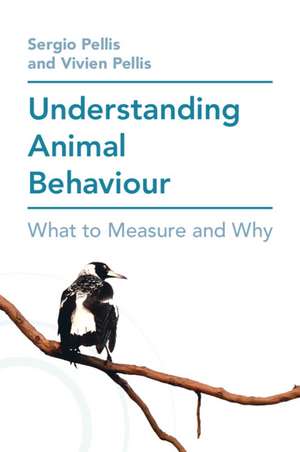Understanding Animal Behaviour: What to Measure and Why
Autor Sergio Pellis, Vivien Pellisen Limba Engleză Paperback – 19 mai 2021
| Toate formatele și edițiile | Preț | Express |
|---|---|---|
| Paperback (1) | 271.82 lei 22-36 zile | +15.70 lei 6-12 zile |
| Cambridge University Press – 19 mai 2021 | 271.82 lei 22-36 zile | +15.70 lei 6-12 zile |
| Hardback (1) | 492.81 lei 22-36 zile | |
| Cambridge University Press – 19 mai 2021 | 492.81 lei 22-36 zile |
Preț: 271.82 lei
Nou
Puncte Express: 408
Preț estimativ în valută:
52.03€ • 56.53$ • 43.73£
52.03€ • 56.53$ • 43.73£
Carte disponibilă
Livrare economică 31 martie-14 aprilie
Livrare express 15-21 martie pentru 25.69 lei
Preluare comenzi: 021 569.72.76
Specificații
ISBN-13: 9781108705103
ISBN-10: 1108705103
Pagini: 166
Dimensiuni: 153 x 228 x 10 mm
Greutate: 0.27 kg
Editura: Cambridge University Press
Colecția Cambridge University Press
Locul publicării:Cambridge, United Kingdom
ISBN-10: 1108705103
Pagini: 166
Dimensiuni: 153 x 228 x 10 mm
Greutate: 0.27 kg
Editura: Cambridge University Press
Colecția Cambridge University Press
Locul publicării:Cambridge, United Kingdom
Cuprins
Preface; Acknowledgements; 1. What is the problem and what is the solution?; 2. Behaviour as a means, not an end; 3.The deep structure of behavior; 4. The brain is not alone; 5. Bringing it all together: steps in the descriptive process; 6. What of the future?; Epilogue; Appendix A. Eshkol–Wachman movement notation and descriptive analysis; Appendix B. Practice, practice, practice; References; Index.
Recenzii
'Describing what animals actually do in their normal daily activities was deemed essential by the early naturalists and ethologists. Today, many journals actively discourage publishing such research findings. What the Pellis team accomplishes in this book is to document, based on their and others' extensive experience and accomplishments, that careful description can itself be hypothesis driven and answer research questions that experiments with simple, but convenient, dependent measures cannot. This compact guide elegantly shows how to use modern methods to describe and quantify behaviour and embed findings in the behaviour systems in which they occur. From seemingly simple behaviour patterns such as righting, huddling, and reaching, to fighting, foraging, play, and courtship, the authors provide myriad insights and research guidance. Today, in a rapidly changing world, it is more essential than ever to study how the behaviour of animals is being altered, both in natural communities and in experimental laboratories.' Gordon M. Burghardt, University of Tennessee, USA
'The Pellis' little book is a big gift box in which you'll find a trove of crafted ideas and handy examples of how behaviour can be analysed in ways that reveal marvellous, unsuspected dimensions of behavioural organisation. Using some of the “simplest” and most common individual and social acts in animal behaviour, they offer observational and analytic tools for seeing the deep structure of behaviour and how, in some cases, their approach can take us into the brain or out to emergent levels of organisation. Practical for students and researchers, and delightful for science-oriented fans of organisms. Put it on your shelf for repeated openings and explorations.' Jeffrey R. Alberts, Indiana University, Bloomington, USA
'… a fascinating new way of considering animal behavior … This would be a most useful text for any student or researcher of animal behaviors … Highly recommended.' D. C. Marston, Choice Magazine
'The Pellis' little book is a big gift box in which you'll find a trove of crafted ideas and handy examples of how behaviour can be analysed in ways that reveal marvellous, unsuspected dimensions of behavioural organisation. Using some of the “simplest” and most common individual and social acts in animal behaviour, they offer observational and analytic tools for seeing the deep structure of behaviour and how, in some cases, their approach can take us into the brain or out to emergent levels of organisation. Practical for students and researchers, and delightful for science-oriented fans of organisms. Put it on your shelf for repeated openings and explorations.' Jeffrey R. Alberts, Indiana University, Bloomington, USA
'… a fascinating new way of considering animal behavior … This would be a most useful text for any student or researcher of animal behaviors … Highly recommended.' D. C. Marston, Choice Magazine
Notă biografică
Descriere
Studying behaviour in animals requires numerical measurement. This book provides a scientific framework for what to measure and why.
